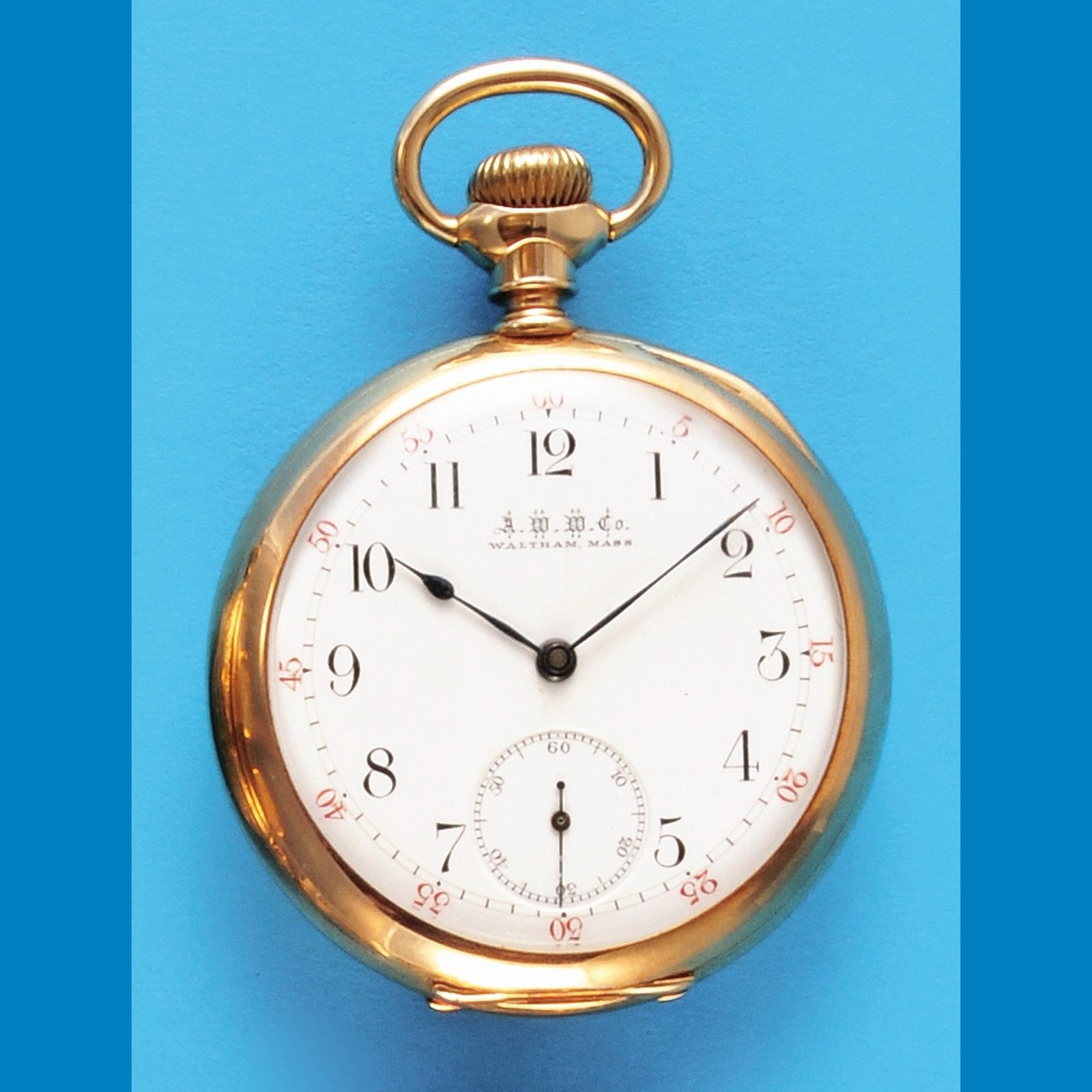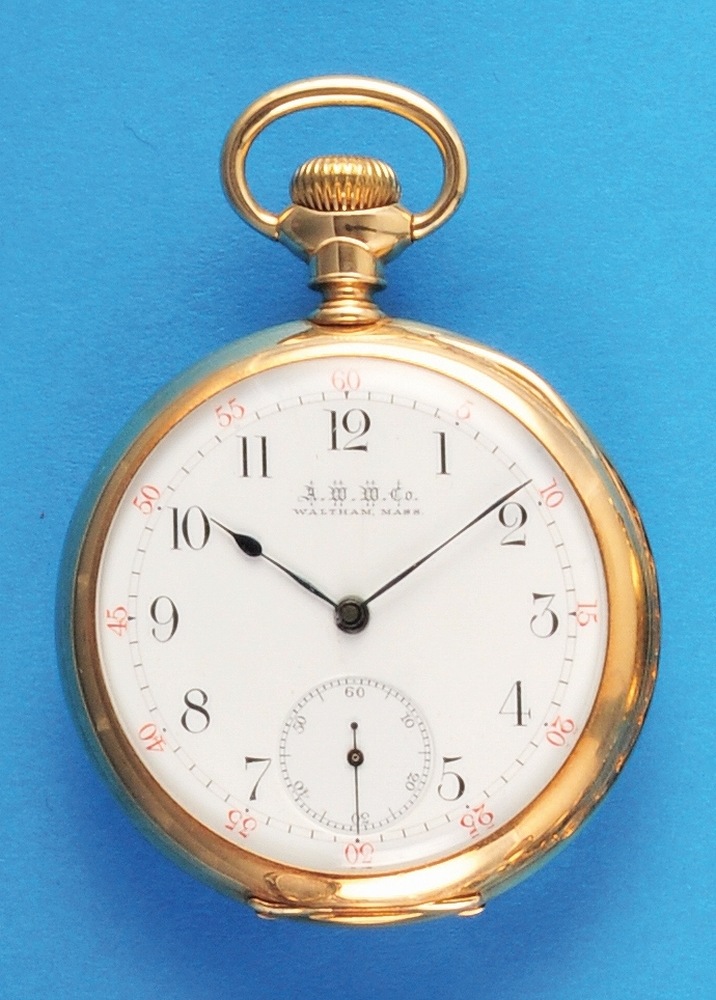AMERICAN WATCH CO., WALTHAM. AN IMPORTANT SILVER GILT HUNTER CASED WATCH MADE FOR THE U. S. MILITARY TELEGRAPH SERVICE DURING THE CIVIL WARDate: July 1864 Movement: Key wound 11-jewel 18-size M1857 gilt full plate signed P. S. Bartlett, jewels in mock screwed settings, lever escapement, gold three arm balance, flat spring, no. 123610 Dial: White enamel, roman chapters, subsidiary seconds, blued Breguet hands Case: Engine turned silver gilt, engraved U.S. within cartouche on front lid, cuvette engraved "No. 11 / U. S. / MILITARY TELEGRAPH", case signed "AM WATCH CO. / WALTHAM. / MASS. / KK7", later bow Signed: Case, dial and movement Size: 54 mm Accompaniments: Certificate dated July 31, 1866 presenting the watch to John H. Emerick, Chief Operator, Army of the James, together with a small archive of information about Emerick. FootnotesProvenance One of 11 watches purchased by the U. S. War Department for use by the Military Telegraph Service "...to establish uniform time in the Army of the Potomac" Presented after the Civil War in 1866 to John H. Emerick, Chief Operator, Army of the James, "as an acknowledgement of the meritorious and valuable services you have rendered to the Government during the war." Thence by descent John H. Emerick (1843 – 1902) was a senior telegraph operator and cipher clerk for the Union Army during the Civil War. (seated, third from left in an 1864 photograph.) He entered the newly formed Military Telegraph Service in 1861. At the age of 17, he was the youngest cipher clerk in the U. S. Army. He served throughout the war with Generals McClelland, Burnside, Hooker and Meade among others. He was commended for his service reporting the operations of Union cavalry under the command of General Alfred Pleasonton in 1863. Emerick managed to establish the Union telegraph lines into Richmond the same day it was captured in 1865. After the war, he continued his work as a telegrapher becoming general superintendent of the Postal Telegraph Company of New York. Before the start of the Civil War, there were just three major telegraph companies in operation. After the onset of hostilities in April 1861, it became apparent that the telegraph lines were vulnerable to disruption. Due to the threat to railroads and telegraphic communication in Washington, the commercial telegraph lines surrounding the city were seized by the order of the Secretary of War. He then requested the president of the Pennsylvania Railroad to get the railroad telegraph service in Washington under control. Four experienced telegraph operators from the Pennsylvania Railroad were recruited, forming the initial United States Military Telegraph Corps. The corps would ultimately grow to a force of over 1500 men. Although the U.S. Military Telegraph Corps played a prominent role in transmitting messages to and from commanders in the battlefield, they remained civilians. All of the orders the telegraph operators received came directly from the Secretary of War. Despite this source of periodic friction, Union generals made extensive use of telegraphed intelligence. David Homer Bates, one of the original telegraph operators wrote in his memoire, Lincoln in the Telegraph Office (New York, The Century Co. 1907) "In our Civil War the Morse telegraph was for the first time employed to direct widely separated armies and move them in unison, and news of victories or defeats was flashed almost instantly all over our broad land. In fact, the history of our Civil War was largely recorded by the telegraph, and that branch of the service Stanton, the great War Secretary, called his "right arm."" Abraham Lincoln enthusiastically adopted the new technology. Bates, recalled that several times a day, Lincoln sat down at a telegraph office desk near a window overlooking Pennsylvania Avenue and read through the fresh stack of incoming telegrams, which he called "lightning messages." He visited the office nearly every night before turning in and slept there on a cot durin
AMERICAN WATCH CO., WALTHAM. AN IMPORTANT SILVER GILT HUNTER CASED WATCH MADE FOR THE U. S. MILITARY TELEGRAPH SERVICE DURING THE CIVIL WARDate: July 1864 Movement: Key wound 11-jewel 18-size M1857 gilt full plate signed P. S. Bartlett, jewels in mock screwed settings, lever escapement, gold three arm balance, flat spring, no. 123610 Dial: White enamel, roman chapters, subsidiary seconds, blued Breguet hands Case: Engine turned silver gilt, engraved U.S. within cartouche on front lid, cuvette engraved "No. 11 / U. S. / MILITARY TELEGRAPH", case signed "AM WATCH CO. / WALTHAM. / MASS. / KK7", later bow Signed: Case, dial and movement Size: 54 mm Accompaniments: Certificate dated July 31, 1866 presenting the watch to John H. Emerick, Chief Operator, Army of the James, together with a small archive of information about Emerick. FootnotesProvenance One of 11 watches purchased by the U. S. War Department for use by the Military Telegraph Service "...to establish uniform time in the Army of the Potomac" Presented after the Civil War in 1866 to John H. Emerick, Chief Operator, Army of the James, "as an acknowledgement of the meritorious and valuable services you have rendered to the Government during the war." Thence by descent John H. Emerick (1843 – 1902) was a senior telegraph operator and cipher clerk for the Union Army during the Civil War. (seated, third from left in an 1864 photograph.) He entered the newly formed Military Telegraph Service in 1861. At the age of 17, he was the youngest cipher clerk in the U. S. Army. He served throughout the war with Generals McClelland, Burnside, Hooker and Meade among others. He was commended for his service reporting the operations of Union cavalry under the command of General Alfred Pleasonton in 1863. Emerick managed to establish the Union telegraph lines into Richmond the same day it was captured in 1865. After the war, he continued his work as a telegrapher becoming general superintendent of the Postal Telegraph Company of New York. Before the start of the Civil War, there were just three major telegraph companies in operation. After the onset of hostilities in April 1861, it became apparent that the telegraph lines were vulnerable to disruption. Due to the threat to railroads and telegraphic communication in Washington, the commercial telegraph lines surrounding the city were seized by the order of the Secretary of War. He then requested the president of the Pennsylvania Railroad to get the railroad telegraph service in Washington under control. Four experienced telegraph operators from the Pennsylvania Railroad were recruited, forming the initial United States Military Telegraph Corps. The corps would ultimately grow to a force of over 1500 men. Although the U.S. Military Telegraph Corps played a prominent role in transmitting messages to and from commanders in the battlefield, they remained civilians. All of the orders the telegraph operators received came directly from the Secretary of War. Despite this source of periodic friction, Union generals made extensive use of telegraphed intelligence. David Homer Bates, one of the original telegraph operators wrote in his memoire, Lincoln in the Telegraph Office (New York, The Century Co. 1907) "In our Civil War the Morse telegraph was for the first time employed to direct widely separated armies and move them in unison, and news of victories or defeats was flashed almost instantly all over our broad land. In fact, the history of our Civil War was largely recorded by the telegraph, and that branch of the service Stanton, the great War Secretary, called his "right arm."" Abraham Lincoln enthusiastically adopted the new technology. Bates, recalled that several times a day, Lincoln sat down at a telegraph office desk near a window overlooking Pennsylvania Avenue and read through the fresh stack of incoming telegrams, which he called "lightning messages." He visited the office nearly every night before turning in and slept there on a cot durin














Try LotSearch and its premium features for 7 days - without any costs!
Be notified automatically about new items in upcoming auctions.
Create an alert